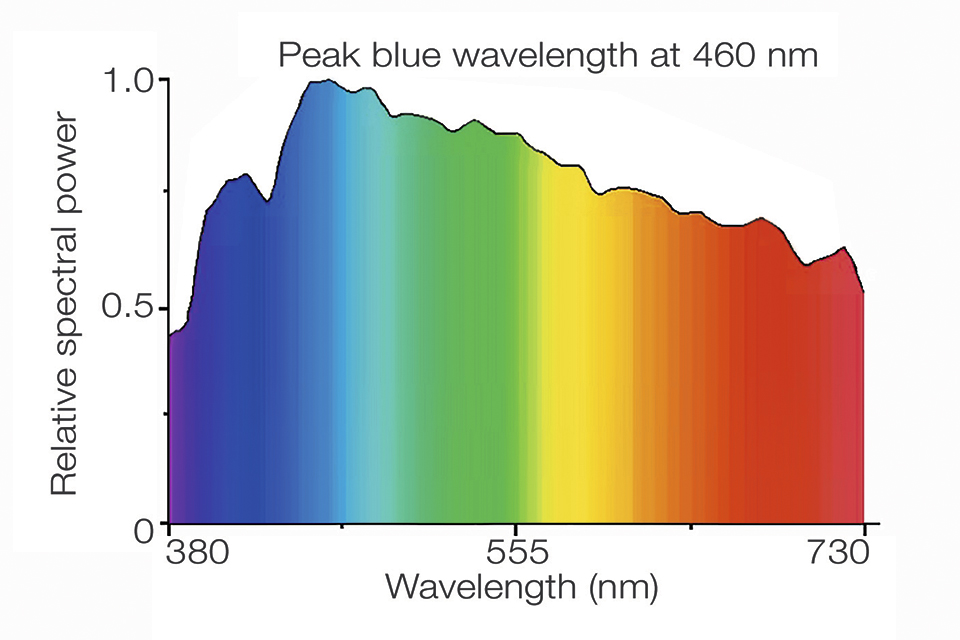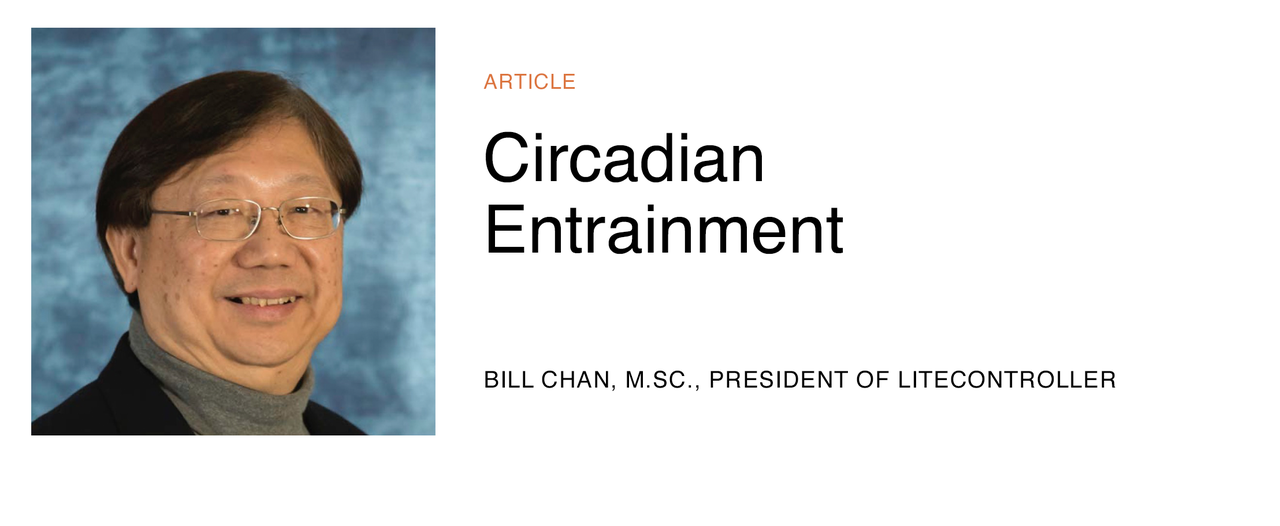Adopting an LED More Suited to Circadian Entrainment
Since the introduction of LED lights, a lot has been said about risks of blue light for ocular health on the one hand, and the opportunity of circadian entrainment, on the other hand. While a controversial discussion on the first topic is ongoing, the second topic is well accepted. To solve both issues, Bill Chan, President of LiteController Inc. proposes the application of 465-470nm pumped phosphor converted white LEDs with a content of 86% - 92% blue-turquoise light and 8% - 14% blue-violet light. In the article he concentrates on the second topic and proves the benefit of regulating the circadian entrainment more efficiently, maintaining a high typical efficacy of 150 lm/W and good color rendering of CRI 80+ ideally supporting the WELL Building Standard.
Light plays a vital role in our daily life. Besides helping us with visual effect, light also has important non-visual biological effects on the human body. Good human-centric lighting provides positive influence on health, alertness, well-being, and even sleep quality.
During daytime, sunlight plays the most significant part in regulating the Circadian Rhythm of human body. Nowadays, people are spending more and more time indoors during the day, and thus the time of the eyes being exposed to blue-enriched sunlight is reduced. The average noon daylight in North America and Europe can be represented by the CIE D65 illuminant, as shown in Figure 1. Eye exposure to appropriate amounts of sunlight during the daytime is healthful, and it helps cognitive function, elevates moods and synchronizes body-clock.
 Figure 1: Relative Spectral Power - CIE D65 Illuminant
Figure 1: Relative Spectral Power - CIE D65 Illuminant
Sunlight and Blue Light
Medical studies have shown that blue light in the nighttime suppresses the body to secrete Melatonin (a.k.a. Sleep Hormone), which is required for a good night's sleep. Consequently, our natural sleep-wake cycles can be disrupted by excessive exposure to blue light during the night. So, we should avoid our eyes exposed to bright blue-enriched artificial lighting and electronics screens before going to bed. Disruption of natural sleep-wake cycles may be linked to depression, diabetes and obesity.
Brainard et al. [1] has shown that blue light is the most potent wavelength range to influence the circadian entrainment by suppressing Melatonin secretion, and quantum sensitivity peaks at 464 nanometers. Thapan et al. [2] also shows similar findings.
Circadian Entrainment
Equivalent Melanopic Lux (EML) metrics is adopted by WELL Building standard v2 to assess the circadian entrainment of the lighting environment. This metrics transforms the amount of light entering the cornea at a vertical pane into an EML value, and this EML value is weighted to the spectral response of the ipRGC cells in the retina. EML metrics is based on the SPD (Spectral Power Distribution) and Circadian index (or also known as Melanopic Sensitivity) of individual wavelength to come up with the Melanopic Ratio. The EML value is equal to the product of the vertical illuminance and the Melanopic Ratio. The Circadian index used in the calculation of Melanopic Ratio is shown in Figure 2, and it starts to rise from 0.0795 (at 415 nanometers) to 0.6297 (at 455 nanometers) and then to 1 (at 490 nanometers). It demonstrates that blue-turquoise light (456 – 490 nanometers) is more efficient than blue-violet light (415 – 455 nanometers) to regulate the circadian entrainment. After that, the Circadian index starts to decline and reach 0 at 660 nanometers, i.e., red light wavelength.
 Figure 2: Circadian index
Figure 2: Circadian index
Retinal Blue-Light Hazard - IEC/EN 62471
Apart from the influence on circadian entrainment, blue light also has another biological effect on the eyes. The details are illustrated in the standard IEC/EN 62471 (Photobiological safety of lamps and lamp systems). The Retinal Blue-Light Hazard stated in IEC/EN 62471 is related to the Photoretinitis, i.e., photochemical retinal hazard caused by high-energy incident light to instigate damage in the retina. Its quantifying parameter is LB (Retinal Blue Light Radiance), which determines the LED to fall into which risk group of Blue Light Hazard. There are four risk groups having different limits of LB, and for example, Exempt Risk Group specifies a LB limit of 100 Wm-2sr-1. LB is the sum of products of Lλ (spectral radiance) and Bλ (blue light hazard sensitivity) at each wavelength. Bλ curve (Figure 3) rises sharply from 400 nm and peaks at 435 and 440 nm. It demonstrates that the blue-turquoise light will produce lower LB than the blue-violet light. After that, Bλ gradually declines to negligible value at 550 nm.
 Figure 3: Bλ (Blue Light Hazard Sensitivity)
Figure 3: Bλ (Blue Light Hazard Sensitivity)
Blue-violet Light and Blue-turquoise Light
Blue light (415-490 nm) consists of two components, i.e., blue-violet light (415-455 nm) and blue-turquoise light (456-490 nm). Based on the sensitivities illustrated in Figure 2 and 3, a higher dosage of blue-turquoise light is always preferred to blue-violet light for indoor lighting during daytime, because of two advantages.
Two major advantages of blue-turquoise light:
• Higher EML (Equivalent Melanopic Lux) to improve the efficiency
of regulating the Circadian Rhythm
• Lower LB (Retinal Blue Light Radiance) can be achieved
LiteBlue LED vs Standard LED
Standard LED of 440-450 nanometers blue pump emits a mixture ratio of blue-violet light and blue-turquoise light by 0.5:0.5 roughly, depending on the color temperatures. By shifting the wavelength of blue pump to 465-470 nanometers, LiteBlue LED emits a mixture ratio of blue- violet light and blue-turquoise light by 0.1:0.9 roughly, and their mix percentages are listed in Table 1. As a result, LiteBlue LED has the advantages of higher efficiency of EML to regulate Circadian Rhythm, and at the same time, LB can also be lowered significantly.
 Table 1: Blue light content of LiteBlue LED
Table 1: Blue light content of LiteBlue LED
Benefits of LiteBlue LED
Taking 5000 K CCT color temperature as an example, LiteBlue LED emits about 86% blue-turquoise light and 14% blue-violet light. The SPD comparison of LiteBlue LED with a standard LED is shown in Figure 4. It shows that the standard LED emits half of the blue-turquoise light content of LiteBlue LED, and at the same time, three times more of blue-violet light content.
 Figure 4: Comparison of SPD between LiteBlue LED's and Standard LED's
Figure 4: Comparison of SPD between LiteBlue LED's and Standard LED's
The comparison of LiteBlue LED with sample standard LED in terms of EML and LB is shown in Table 2 for various color temperatures, and they all have a footprint of 2835. Because of its higher content of blue-turquoise light, LiteBlue LED emits 26% more EML than standard LED. Hence, LiteBlue LED can achieve equivalent circadian entrainment at a lower light intensity level. In other words, LiteBlue LED offers the advantages of saving energy and reducing eye discomfort to users, when higher light intensity level of standard LED is used. Also, about 20% reduction of LB can be achieved because of the blue-turquoise light enriched spectrum being less sensitive to Bλ, when compared with standard LED.
 Table 2: Comparison of EML and LB of LiteBlue LED's with sample standard LED's
Table 2: Comparison of EML and LB of LiteBlue LED's with sample standard LED's
Luminous Efficiency and CRI of LiteBlue LED
LiteBlue LED offers satisfactory performances in Luminous Efficiency and CRI, which are of 150 lm/W and minimum 80% respectively. Assuming 85% efficiency of optic and driver, LiteBlue LED can meet the minimum requirement of 125 lm/W and 80% CRI for indoor troffer as specified by the DLC (DesignLights Consortium) Premium requirement. DLC Certification is an energy rebate program from the U.S. and Canadian governments to encourage the use of LED lighting products.
In the latest version of DLC V4.4, the requirements of Troffer
are listed as follows [3]:
• DLC Standard requirement for troffer – Efficacy of 100 lm/W and
80% CRI and above
• DLC Premium requirement for troffer – Efficacy of 125 lm/W and
80% CRI and above
Android App – Circadian Light Meter
Different workstations inside the office premises may experience different circadian entrainment, especially for those sitting inside a cubicle. In order to facilitate its assessment at a specific position of the office worker, an Android app called "Circadian Light Meter" has been developed for free download [4]. This app makes use of the light sensor and accelerometer of the Android phone to determine the vertical illuminance, after the user aligns his/her cell phone vertically near the eyes. Then the circadian entrainment is calculated according to two different metrics, namely, Equivalent Melanopic Lux and Circadian Stimulus. The Android app's user interface is shown in Figure 5.
 Figure 5: User interface of Circadian Light Meter app
Figure 5: User interface of Circadian Light Meter app
Conclusions
While there may be still some research required to come to an optimal solution in all LED lighting applications, the required technology to improve LED lighting to become healthier is available and some studies indicate the benefit of the proposed solution. As even very stringent lighting standards are satisfied with this solution, why should wait longer? Why shouldn't we apply it immediately?
References:
[1] Action spectrum for melatonin regulation in humans: evidence for a novel
circadian photoreceptor, Brainard GC et al., J Neurosci.
2001 Aug 15;21(16):6405-12
[2] An action spectrum for melatonin suppression: evidence for a novel non-rod,
non-cone photoreceptor system in humans, Thapan K et al., J Physiol.
2001 Aug 15;535(Pt 1):261-7
[3] https://www.designlights.org/solid-state-lighting/qualification-requirements/technical-requirements/
[4] https://play.google.com/store/apps/details?id=com.litecontroller.clm

